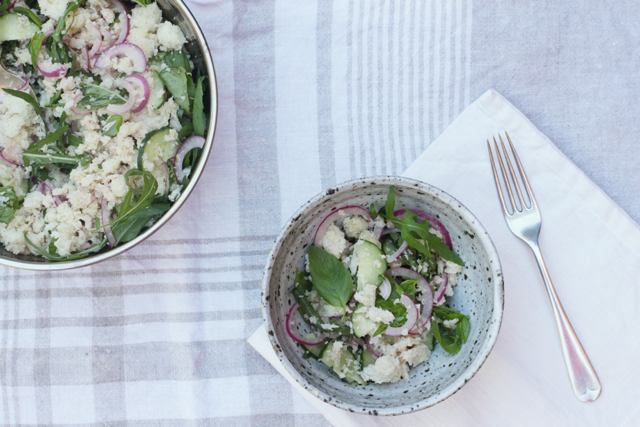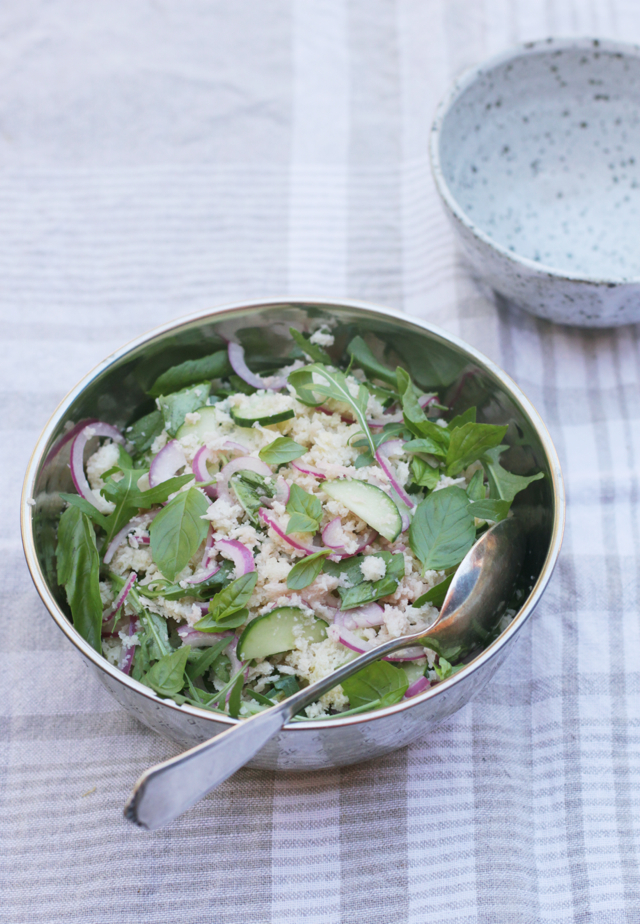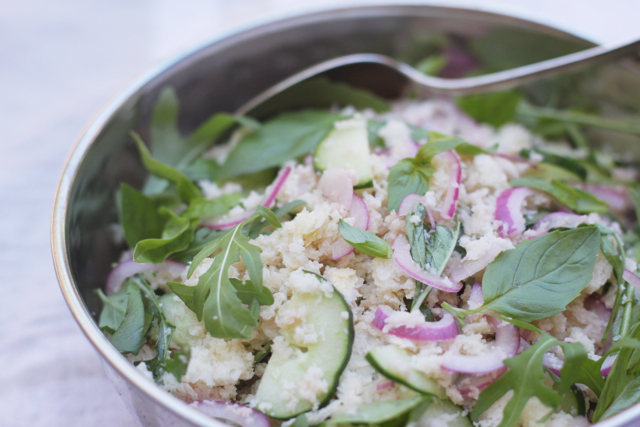Summer wouldn’t be summer without that perfect salad, a must when it’s simply too hot to cook and all you crave are the season’s fresh offerings. Things like this caprese salad, made with heirloom tomatoes straight out of the garden and torn hunks of buffalo mozzarella. In Tuscany, it’s always and forever, panzanella, a rustic bread salad born as a way of using up day old bread and the abundance of fresh vegetables straight from the fields.

Today, panzanella is usually made with ripe summer tomatoes, thinly sliced red onion and torn basil. Often cucumbers make an appearance, but this salad most likely began as an onion-based dish. Many Tuscans, in fact, only remember having the luxury of tomatoes (and for some areas, basil too) added to their panzanella after the Second World War.
It’s a centuries-old recipe that can even be traced back to the Middle Ages with a dish that Boccaccio called “pan lavato” – washed bread. It’s quite an instinctive thing to do when thriftiness counts. Old mariners of the Tuscan and Ligurian coast used to dip their bread (dried out to make it last long periods) in the sea to revive it and season it before adding it to their meals.

Well before tomatoes became a staple in Italian kitchens, the Florentine Renaissance painter, Bronzino (1503-1572), immortalised a recipe that resembles in all ways today’s panzanella, minus the fresh tomato. His salad consisted simply of chopped onion, cucumbers, bread, wild greens and perhaps some basil and rocket, all noted down in this elegant little ode to this salad, where he likens it to a trip across the stars:
chi vuol trapassar sopra le stelle / en’tinga il pane e mangia a tirapelle / un’insalata di cipolla trita / colla porcellanetta e citriuoli / vince ogni altro piacer di questa vita / considerate un po’ s’aggiungessi bassilico / e ruchetta
Tomatoes are native to the Americas and were brought over to the Italian peninsula via Spain in the early sixteenth century. Initially the plant was viewed with suspicion by some and was kept at first as an ornamental plant. It wasn’t well into the 1600s that tomatoes began to be used regularly in the kitchen. Gillian Riley notes that by the time the tomato conquered Italian kitchens, tomatoes had crept into “ancient historic dishes which might have been better without them.” This, I imagine, is one of the dishes, along with pappa al pomodoro, that she had in mind.

Stale Tuscan bread has an incredible consistency when soaked with liquid. It doesn’t become soggy the way many other breads would when submerged in vinegar and water. It holds its shape well, it remains springy and the crumbs remain intact. It’s a character not easy to find with other breads. Many non-Italian recipes call for toasting the bread, which is unorthodox (and not recommended, personally) but if you are not using bread that is similar to Tuscan bread, you may not have a choice – just know it is not quite the same.
Like many casalinga recipes, panzanella recipes tend to change slightly from house to house and province to province or according to what you have on hand. I personally like a panzanella that is firm, not mushy, with thinly sliced (even transparent) sweet red onions that are not over-powering. I do love tomatoes in my panzanella as well, but following Bronzino’s advice makes a nice, fresh, green alternative; a version of the salad where the bread really becomes the hero. Any panzanella is best prepared about an hour before serving to give time for the flavours to combine but it does not keep well for more than a day as the fresh ingredients tend to get ruined by the vinegar, so make the amount as you need. For this reason, the measurements are approximate, but keep in mind that the bread should make up half of the volume of this salad.
It’s a wonderful salad to take along to a picnic as it travels and keeps well, or to have alongside some simple grilled fish or meat. It also makes a great summertime lunch just on its own, but if you wanted to make it a more substantial meal, it’s not unusual to see tinned tuna or perhaps some torn buffalo mozzarella or good, black olives added to this.

Bronzino’s Panzanella salad
There are those that keep the crust on the bread and those that remove it. I say it depends on the bread and its staleness, but sometimes (when quite stale, especially) the crust doesn’t get soft enough and tends to stay very chewy when moistened. In this case, it’s best to remove it. Depending on the bread’s ability to absorb liquid, you may want to prepare a small bowl with water and a splash of vinegar to soak the bread, or you can simply run it once, quickly, under a running tap (my preference).
- About 4-5 thick slices of stale Tuscan bread or white country bread (about 250 grams)
- 1 very crunchy cucumber (I like to leave the skin on; Italians will usually peel theirs)
- 1 small red onion
- Handful of rocket leaves, washed and pat dry (peppery wild rocket is best)
- Handful of basil leaves
- Extra virgin olive oil
- Red wine vinegar
- Salt and pepper to taste
Pass the slices of bread under running water and let sit in a bowl to soften.
Slice the red onion very thinly (it should be transparent) and place in a bowl sprinkled with some of the red wine vinegar to take the edge off.
Slice the cucumber thinly and place in a separate bowl together with the basil leaves and rocket. When the bread pieces are springy to the touch, remove the crusts (if necessary) and tear and crumble the rest of the bread in your hands into the bowl with the cucumber and rocket. If the bread is still too hard ,you can sprinkle on some more water, but keep in mind that you’ll be adding vinegar and oil to the salad as well, which the bread will also soak up. If you have added too much water, simply give your bread a squeeze to remove the excess liquid before adding to the salad.
When the onions have lost some of their pungency (taste one), drain and add to the salad. Season with a good pinch of salt, a few twists of pepper, a healthy dose of olive oil, a splash or two of red wine vinegar and toss until well combined. Add the basil leaves, torn into pieces just before serving. If you want to make the modern panzanella, simply add 2-3 chopped, fresh tomatoes along with the cucumber.





Comments
What a lovely, fresh and summery panzanella! This combination is marvelous.
Cheers,
Rosa
Love the summery feel this salad brings Emiko. If you can’t change the weather outside, the least one can do is delude self with the food..hehe
And your post evokes some very curious questions too. It is amazing how a non-indigenous plant completely takes over the cuisine of an adopting nation. Most people are shocked to find that the tomato was not originally Italian at all given its pre-eminence in today’s Italian cuisine. And, I do agree that perhaps there are several dishes that were better off before the tomato made its way into them.
I think something of a similar nature is happening with corn and the Americas. It is in everything! And, much like the tomato, it has little nutritional value. Unlike the tomato, however, humans actually cannot process corn! Irony 🙂
I always battle with the reverse seasons thing! Here we’re in the middle of a rather intense summer heatwave and salad is the best dinner at the moment, but I know most of my readers from the Northern Hemisphere might be shivering thinking of salad! Ha. It’s interesting isn’t it, the movement of vegetables over the centuries and things we think of as identifying in a culture. In Northern Italy, for example, rice for risotto and corn for polenta are staples but they were imported centuries ago from the Middle East and the Americas!
Love the thriftiness of the bread salads. What bread do you use in Australia that has the most similar consistency to Tuscan. Is Cassalinga bread a good match a lot of sour dough bakeries make a fairly sturdy but not too heavy casalinga loaf.
Such a good question! I look for a good casalinga loaf – I’m fortunate to have found in both Australian cities that I’ve lived in (Melbourne and Canberra) some great sources of wood-fired artisan bread (will explore Sydney soon too but can’t yet report back on that!). I find sourdough is a bit too dense; you want something a little bit airy and white. Usually a good Italian supermarket should have the right thing, perhaps a round loaf or even a bastone or baguette-like loaf.
Looking forward to when it is warm enough to make this…we did have a glimpse of sun today but then it went away. I love the ode. beautiful pictures, as always, can’t wait..R
Thanks Rachel, looking forward to chatting (and eating) more about things like this with you soon!
Article writing is also a fun, if you be familiar with afterward you can write if not
it is complicated to write.
As so much great Italian food is based on the concept of Cucina Povera – poor folks’ food – re-using bread is a strategy you find all over the country. So I urge you to try “Capunata/Cialda Leccese”, from Salento, in sun-drenched Puglia. They key is to get some good authentic “frisa” – a very special, twice baked bread. You find it all over Puglia, Basilicata and Campania, and since it keeps for a very long time, it’s also often sold in other big cities in Italy. Remember! You must re-constitute it, by soaking, but don’t over-soak it, and be sure to let it rest sevral minutes afterward, to fully absorb the water and expand. It should be puffy and moist, but NOT watery or soggy.
What a lovely blog post. 🙂
I really loved your post. I read your blog quite often and
I just shared it on Twitter. Keep up the good
work.